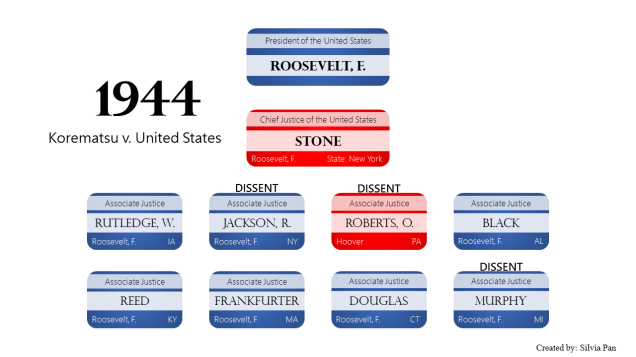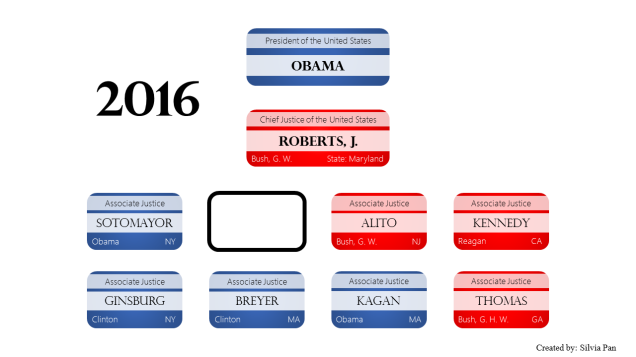Supreme Court of the United States: 1940 – 2016
From the time between 1860s to 1930s the political platform of the Democratic and Republican party started to “switch.” The Democrats who once favored a small central government now supported a larger one and the opposite happened for the Republicans. FDR’s presidency in the 1940s further cemented this relationship between the political parties and their platforms. [1]
One of the president’s role is nominating candidates to fill vacant justice roles in the Supreme Court of the United States. The Senate votes and if a majority agree, the nominee is appointed a Justice of the Supreme Court.
How has the Supreme Court changed from 1940 until now? Below are the presidents and justices in office from 1940 until 2016, along with their political affiliation. [2] [3]
Red denotes Republican and Blue, Democrat.
Landmark Cases
Being the highest ranking court in the United States, a Supreme Court decision sets the precedent for all other court decisions in the country. A Supreme Court decision is the final say on a matter unless the decision becomes overturned by a subsequent decision or a Constitutional amendment approved by the Congress and the states.
Now to take a look at four famous cases and the makeup of the Court during each period starting with:
Korematsu v. U.S. (1944)
Facts: At the start of World War II FDR issued an executive order that banned all people of Japanese descent from living in specific areas along the West Coast. Tens of thousands of American citizens of Japanese descent were forced to sell their homes and held in internment camps. One citizen, Fred Korematsu, refused to leave his home and was convicted for defying the order. [4]
Issue: Did the President and the Congress have the power to restrict the rights of Americans of Japanese descent?
Verdict: Yes, a 6-3 majority of the Supreme Court decided that it was constitutional to place the citizens in internment camps during times of emergency and peril.
President and Supreme Court in 1944:

Brown v. Board of Education (1954)
Facts: The decision of the Supreme Court case Plessy v. Ferguson upheld the constitutionality of the racial segregation. Black children were not allowed to attend the same schools as white children. The schools operated under the doctrine of “separate but equal” but the quality in education differed between black and white schools and the segregation contributed to the low self-esteem of black schoolchildren. [5]
Issue: Are racially segregated schools “inherently equal?”
Verdict: The Supreme Court unanimously ruled that separate public schools were inherently unequal, thus overturning the decision of Plessy v. Ferguson. Racial integration of public schools soon followed, which was met with violent opposition.
President and Supreme Court in 1954:

Roe v. Wade (1973)
Facts: Jane Roe, a single unmarried woman, wished to terminate her pregnancy. However, according to Texas laws she could not get an abortion unless the pregnancy posed a risk to the mother’s life. She did not have the means to travel to another location to have the procedure done.
Issue: Under the Constitution, does a woman have the right to end pregnancy with an abortion?
Verdit: Yes, a 7-2 majority voted that a woman has the right to get an abortion, reasoning that it falls under the right of personal privacy. The right of privacy, whether protected by the Fourteenth or Ninth Amendment, was broad enough to be interpreted to include a woman’s right to get an abortion. [6]
President and Supreme Court in 1973:

Obergefell v. Hodges (2015)
Facts: Marriage laws differed by states. States such as Ohio, Michigan, Kentucky, and Tennessee banned same-sex marriages. Groups of same-sex couples from those states argued that the bans preventing them from getting married were unconstitutional.
Issue: Is it a constitutional right for states to license and recognize same-sex marriages?
Verdict: Yes, a 5-4 majority ruled that marriage is a fundamental liberty, which applies to both same-sex and opposite-sex couples. Therefore, states cannot deny the same-sex couples the right to get married. [7]
President and Supreme Court in 2015:

Current Face of the Supreme Court
With the recent death of Justice Antonin Scalia, who will President Obama nominate for the vacancy? In history there have been a total of four female justices, with Obama having appointed two of them: Sonia Sotomayor and Elena Kagan. There is speculation he will nominate another woman for the Supreme Court. If that were true, would the Senate approve of his nomination?

The Supreme Court wields immense power because its rulings change the country and even culture, as seen with Brown v. Board of Education. Some of the pressing concerns now include:
- Use of death penalties
- Legalization of marijuana
- Nationwide gun control
- Limits to reproductive rights
- Protection of privacy
How will the President, Congress, and Supreme Court handle these divisive issues in the coming decades?
1 Wolchover, By Natalie. “Why Did the Democratic and Republican Parties Switch Platforms?” LiveScience. TechMedia Network, 24 Sept. 2012. Web. 04 Mar. 2016.
2 “Political Parties of the Presidents.” Political Parties of the Presidents. N.p., n.d. Web. 04 Mar. 2016.
3 “Compare Supreme Court Justices.” U.S. Supreme Court Justices. N.p., n.d. Web. 04 Mar. 2016.
4 Konkoly, Toni. “Korematsu v. United States (1944).” PBS. PBS, n.d. Web. 04 Mar. 2016.
5 McBride, Alex. “Brown v. Board of Education (1954).” PBS. PBS, n.d. Web. 04 Mar. 2016.
6 “FindLaw’s United States Supreme Court Case and Opinions.” Findlaw. N.p., n.d. Web. 04 Mar. 2016.
7 “Obergefell v. Hodges.” Oyez. Chicago-Kent College of Law at Illinois Tech, n.d. Mar 4, 2016.
